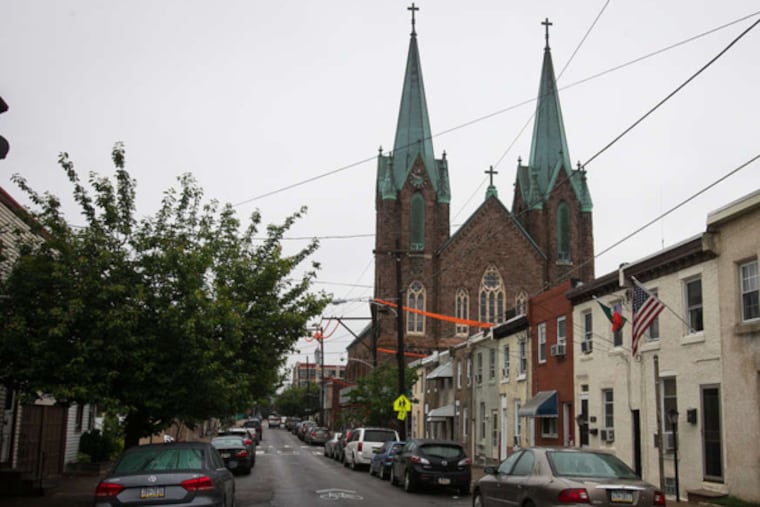Philadelphia urges demolition of St. Laurentius Church, but an architectural committee is unpersuaded
Philadelphia's architectural committee, a subset of the historical commission, denied developer Humberto Fernandini's request to demolish the crumbling, century-old St. Laurentius Roman Catholic Church.

The future of the structurally unstable, century-old St. Laurentius Roman Catholic Church remained muddy Tuesday after the Philadelphia Historical Commission’s architectural committee rejected the idea of demolishing the 19th-century brownstone building.
The committee did not follow a recommendation from the Department of Licenses and Inspections that the commission approve the demolition of St. Laurentius’ increasingly unstable, soaring twin spires.
“Discussion, going forward, should focus upon saving portions of the building, its facades, and artifacts for incorporation into a future building design,” David J. Perri, the L&I commissioner, wrote in a letter on Monday. “We sincerely regret having to provide this sobering report, but the building has simply run out of time, and public safety is our overarching priority.”
The seven-member committee, which acts as an advisory body to the Historical Commission, asked that developer Humberto Fernandini come up with alternatives to rehabilitate the church.
Fernandini bought the building in January for $50,000 from the Archdiocese of Philadelphia and said then that he was “committed to keeping the church standing.”
The committee noted that in the seven months Fernandini has owned the property at 1600 Berks St. in Fishtown, he has not taken any temporary measures to keep the local landmark intact, despite three engineers’ recent warnings that the church was in critical condition.
In recent weeks, Fernandini, of Mountain Lakes, N.J., had asked for permission to tear down the church. Shortly afterward, L&I urged the Historical Commission to review the matter, given the instability of the building, but it did not until Monday provide specific direction about how to resolve the problem.
The architectural committee said Fernandini had not offered alternatives to demolition, for which engineers had suggested pulling down the 150-foot spires into the main body of the church to avoid dropping debris onto neighboring buildings or narrow surrounding streets.
“It’s very disturbing to me that there are no options in front of us,” committee member Amy Stein said during the nearly four-hour Zoom meeting on Tuesday, which at times grew tense between her peers and Matthew McClure, a lawyer who spoke on Fernandini’s behalf.
“We have heard testimony after testimony about one option, which is complete demolition of the building, removal of the towers from the south side, and it’s as if nothing else was studied,” she said. “I do respect the immediacy is part of the concern; safety is part of the concern, but very few applications come in front of us with zero options.... I just don’t know why we’re having the meeting, to be frank, because in all honesty, there are no options except the one you’ve presented.”
McClure said he had little say about limited choice.
“The fact that we are here the way we are with no options is not of our doing,” he replied to Stein. “It is at at the request of the way the city directed us to do this. So I understand the objection, but, you know, please don’t shoot the messenger.”
Dan McCoubrey, the committee’s chair, said it was the owner and not the city who would decide how to take down the building.
McClure, of the Philadelphia law firm Ballard Spahr, reiterated the findings of the structural engineers Fernandini hired this summer to examine the church. Janis Vacca of the Harman Group wrote in her report that the extent of structural damage was so severe that she estimated an 80% chance that one of the spires would partially collapse within three years.
“This is nothing I would ever put a gamble on,” she said during the meeting Tuesday. “I am adamant these towers have to come down.”
Another structural engineer hired by Fernandini — Mark Coggin of the firm Thornton Tomasetti — said he agreed with Vacca’s conclusions.
Preserving parts of the church, such as its eastern or southern walls, would require “some significant structural bracing to hold that in place,” Coggin said. He estimated that it would take six to eight months to construct the bracing and another several months to install it in the church. He said he feared the building couldn’t wait that long.
“But there’s been seven months of ownership,” said Justin Detwiler, an architectural committee member. “And now we don’t have another six months for a design solution to save it.”
Justin Spivey, a structural engineer hired by the Preservation Alliance of Greater Philadelphia, suggested that part of the church could temporarily be supported with metal scaffolding that acted as an exoskeleton during a partial demolition.
But even if Fernandini were to preserve and convert the church for another use, such as apartments — a proposal hearkening back to the idea from the church’s last owner, developer Leo Voloshin — it would be a sunk cost, said Peter Angelides, president of the Philadelphia economic consulting firm Econsult Solutions.
Angelides estimated that it would cost around $3 million to demolish parts of the church. It could perhaps fit up to 25 apartments, some of which would have large, soaring windows, and others with hardly any window at all based on the church’s architecture, he said. He added that there would be no parking in that particular area of Fishtown.
“You would have awkward apartments with no parking,” he said. “You’re going to spend an awful lot of money to partially demolish the church, save what can be saved, and that money then is followed up by a lot more money to build apartment buildings you couldn’t rent for much money. The juice is not worth the squeeze in that one.”
The matter is expected to return to the entire historical commission on Aug. 14.